 Dosa with sambar and chutney Dosa with sambar and chutney | |
| Type | Pancake, crepe |
|---|---|
| Place of origin | India |
| Region or state | Southern India |
| Serving temperature | Hot |
| Main ingredients | Rice and black gram |
| Variations | Masala dosa, rava dosa, ghee roast dosa, podi dosa, paneer dosa, plain dosa, and many more |
A dosa, dosey, dosai, dosha, dose, or dhosa is a thin, savoury crepe in Indian cuisine made from a fermented batter of ground black gram and rice. Dosas are served hot, often with chutney and sambar (a lentil-based vegetable stew). Dosas are a common food in Southern India and in Sri Lanka.
History


The dosa originated in South India, but its precise geographical origins are unknown. According to food historian K. T. Achaya, references in the Sangam literature suggest that dosa was already in use in the ancient Tamil country around the first century CE. However, according to historian P. Thankappan Nair, dosa originated in the town of Udupi in present-day Karnataka. Achaya states that the earliest written mention of dosa appears in the eighth-century literature of present-day Tamil Nadu, while the earliest mention of dosa in Kannada literature appears a century later.
In popular tradition outside of Southern India, the origin of the dosa is linked to Udupi, probably because of the dish's association with Udupi restaurants. The Tamil dosa is traditionally softer and thicker; the thinner and crispier version of dosa was first made in present-day Karnataka. A recipe for dosa can be found in Manasollasa, a 12th-century Sanskrit encyclopedia compiled by Someshvara III, who ruled from present-day Karnataka.
The dosa arrived in Mumbai with the opening of Udupi restaurants in the 1930s. After India's independence in 1947, South Indian cuisine became gradually popular in North India. In New Delhi, the Madras Hotel in Connaught Place became one of the first restaurants to serve South Indian cuisine.
Dosas, like many other dishes of South Indian cuisine, were introduced in Ceylon (Sri Lanka) by South Indian emigrants during British rule. Tirunelveli and Tuticorin merchants who settled there were instrumental in the spreading of South Indian cookery across the island by opening restaurants (vegetarian hotels) to meet initially the needs of the emigrant population. Dosa has found its way into the culinary habits of the Sri Lankan people, where it has evolved into an island-specific version which is quite distinct from the Indian dosa. In both forms, it is called those (තෝසේ or [t̪oːse]) or thosai (தோசை or [t̪oːsaɪ̯]) in Sinhala and in Sri Lankan Tamil.
As in Sri Lanka, dosa was introduced far abroad since the early 18th century, by the migration of the Indian Tamil diaspora to Southeast Asia and later in the Western World, and through the worldwide popularisation of Indian and South Indian cuisines since the second half of the 20th century.
Names
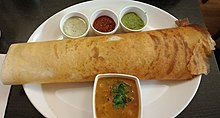

Dosa is the anglicised name of a variety of South Indian names for the dish, for example, dosai in Tamil, dosey in Kannada, and dosha in Malayalam.
The standard transliterations and pronunciations of the word in various South Indian languages are:
| Language | Transliteration | Pronunciation (IPA) |
|---|---|---|
| Tamil: தோசை | dōsai | [d̪oːsaɪ̯] |
| Kannada: ದೋಸೆ | dōse | [d̪oːse] |
| Malayalam: ദോശ | dōśha | [d̪oːʃa] |
| Telugu: దోశ | dōsa | [d̪oːsa] |
Nutrition
Dosa is high in carbohydrates and contains no added sugars. As its key ingredients are rice and black gram, it is a good source of protein. A typical homemade plain dosa without oil contains about 112 calories, of which 84% is carbohydrate and 16% is protein. The fermentation process increases the vitamin B and vitamin C content.
Preparation
A mixture of rice and white gram that has been soaked in water for at least 4–5 hours is ground finely to form a batter. Some add a bit of soaked fenugreek seeds while grinding the batter. The proportion of rice to lentils is generally 3:1 or 4:1. After adding salt, the batter is allowed to ferment overnight, before being mixed with water to get the desired consistency. The batter is then ladled onto a hot tava or griddle greased with oil or ghee. It is spread out with the base of a ladle or a bowl to form a pancake. It can be made either thick like a pancake, or thin and crispy. A dosa is served hot, either folded in half or rolled like a wrap. It is usually served with chutney and sambar. The mixture of white grams and rice can be replaced with highly refined wheat flour or semolina.
-
Rice batter
-
 Batter poured on a tava or griddle
Batter poured on a tava or griddle
-
 Batter being spread uniformly
Batter being spread uniformly
-
After being cooked for some time
Serving
Dosas can be stuffed with fillings of vegetables and sauces to make a quick meal. They are typically served with a vegetarian side dish, which varies according to regional and personal preferences. Common side items are:
- Sambar
- Chutney
- Idli podi or milagaipodi: A lentil powder with spices and sometimes desiccated coconut, mixed with sesame oil or groundnut oil or ghee
- Indian pickles
Variations
Masala dosa is a roasted dosa served with potato curry, chutney, and sambar, while saada (plain) dosa is prepared with a lighter texture; paper dosa is a thin and crisp version. Rava dosa is made crispier using semolina. Newer versions include Chinese dosa, cheese dosa, paneer dosa, and pizza dosa.
Though dosa is typically made with rice and lentils, other versions exist.
| Name | Description |
|---|---|
| Uttapam | A highly popular variety of dosa is much thicker and softer and served with vegetable toppings. It also uses less oil, hence is considered healthier than the typical dosa. On the flipside, though, it takes more time to prepare than a regular dosa. Both surfaces may be baked. They are again eaten like a regular dosa with servings of sambhar and chutney. Its history is as old as the dosa, featuring in Sangam literature. It is closely related to both the dosa and the appam. |
| Masala dosa | Roasted and crispy dosa, served with potato curry, chutney and sambar |
| Oats dosa | Healthy, crisp and lacy instant dosa made with oats |
| Wheat dosa | Dosa made with wheat flour batter, a typical wheat dosa may consume more oil and takes longer to prepare than a regular dosa. Instead of oil, ghee or butter may be used. |
| Set dosa | Smaller, spongy, soft and light, served in a set of 2-3 dosa per serving |
| Red rice dosa | A healthier variant of the regular dosa, it uses red rice instead of white rice, though the batter may also involve a mixture of the two rice varieties, too. |
| Plain dosa | Dosa has light texture and can be crispy. |
| Kal dosai | A thicker, softer, and spongier variant of a plain dosa, it also uses a stone tawa instead of the regular iron tawa for other dosas. |
| Tandoori dosa | A variety of dosa that uses a tandoor to prepare it instead of a tawa |
| Ghee roast | (Nei dosai in Tamil) Plain dosa cooked with ghee instead of oil and usually with no filling |
| Paper roast/Plain roast dosa | A large, plain dosa known for its thin layer and crispiness resulting from making a very thin layer of batter and the addition of extra oil compared to plain dosa |
| Egg dosa | (Muttai dosai in Tamil) A thicker base of dosa topped with beaten egg, or beaten egg is added to batter before cooking. |
| Kari dosai | A Tamil Nadu specialty with a dosa of thicker base topped with cooked meat, usually chicken or mutton: Dosas topped with vegetables or vegetable curry are also sometimes referred to as kari dosai. |
| Madurai Kari dosai | A famous variant of kari dosai is the Madurai kari dosai. This has a vegetarian and a non-vegetarian variant. The latter consists of non-vegetarian toppings of a mix of omlette, minced meat, and without vegetables, while the former has a fully vegetarian topping of vegetable curry. |
| Pori dosa/Puffed rice dosa | Uses some puffed rice alongside raw rice and some lentils in the batter |
| Paneer dosa | Spiced, flavorful paneer filling inside the dosa |
| Palak dosa | Layered with palak (spinach) paste inside the folds of dosa |
| Pizza dosa | A fusion of the traditional dosa and a regular pizza, it comes in many subvariants. It primarily uses toppings that resemble those of a regular pizza. |
| Spring Roll dosa | A fusion of the traditional plain dosa and the spring roll, it has vegetarian and non-vegetarian variants. It uses the same stuffing as in the spring roll and is usually cut and served rolled up as a spring roll. It is also notably spicy (piquant). |
| Jini dosa | A famous variety of dosa from Mumbai, Indiam , it is a crispy, cheesy dosa stuffed with a spicy mix of vegetables such as cabbage, carrots, and capsicum in addition to a tangy sauce. |
| Schezwan dosa | A type of dosa with stuffing of a mix of cooked vegetables and Schezwan sauce |
| Mini soya dosa | Soya milk and wheat flour |
| Pesarattu (green dosa) | Made with green gram. It is served with Allam Pachadi. (Ginger chutney) |
| Adai dosa | From Tamil Nadu, it is a dosa-like dish prepared from a combination of toor dal, rice, curry leaves, red chillies, and asafoetida. The batter is not fermented, and is usually eaten with jaggery or aviyal. |
| Light white dosa | Rice and coconut |
| Kadapa Neyyi karam dosa | Rice flour fermented overnight and mixed with sodium carbonate. The topping is a mixture of onion and chili paste (called yerra karam) and a chutney made with tomato and flour made in a gravy of curd. It is roasted in Ghee. It is also occasionally topped with fried gram powder. |
| Onion rava dosa | Semolina, rice flour, onion |
| Ragi wheat dosa | Ragi, whole wheat flour |
| Rava dosa | Made with rava or sooji (semolina), it is a healthier alternative to regular dosa. Rava dosa takes up more oil than a regular dosa and can stick to the tawa if enough oil is not used. It also takes more time to prepare than a regular dosa. |
| Benne dose | Made with butter (benne in Kannada, vennai in Tamil), it is predominantly famous as Davanagere benne dose associated with the Davanagere district in Karnataka. |
| Neer dosa | Made with a watery rice batter |
| Vodu dose or Kappa roti | Vodu dose or kappa roti is made from unfermented rice, fenugreek, grated coconut, thinly flattened rice, and sometimes leftover cooked rice. It is cooked on an earthen pan with a rounded bottom. It is fluffy and appears like a bread. It is cooked without the use of oil. |
| Amboli, ghavan, dhirde | In coastal parts of Maharashtra, variations known as amboli and ghavan are thin rice crêpes prepared with fermented batter, while dhirde is prepared with unfermented batter. |
| Buttermilk dosa | Semolina, maida, buttermilk |
| Jaggery dosa | Rice flour, maida, grated coconut, jaggery. |
| Minapattu | Very similar to plain dosa, this version tends to be thicker and, compared to plain dosa, it has a greater ratio of urad dal to rice flour or, in some cases, idli rava. |
| Maida dosa | The maida dosa batter is made from maida (refined flour) by adding water to get dense consistency; chopped onion, chilli, coriander leaves, and salt are added for taste. Maida dosa is quickly made in many households of Karnataka state, India. |
-
 Masala dosa served traditionally with chutney, sambar, sauteed potato filling
Masala dosa served traditionally with chutney, sambar, sauteed potato filling
-
 Uttapam is one of the many varieties of dosa prepared in India and served for breakfast.
Uttapam is one of the many varieties of dosa prepared in India and served for breakfast.
-
 Urad plain dosa
Urad plain dosa
-
 Wheat flour dosa
Wheat flour dosa
-
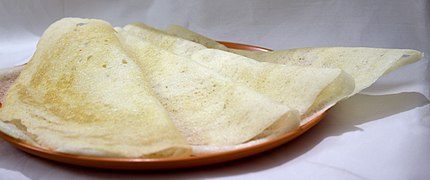 Plain dosa
Plain dosa
-
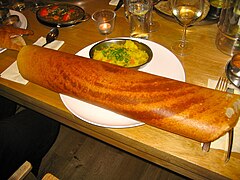 Paper roast, a wafer-thin crispy dosa, served in restaurants
Paper roast, a wafer-thin crispy dosa, served in restaurants
-
 Ghee roast, known as nei dosa in Tamil.
Ghee roast, known as nei dosa in Tamil.
-
Butter dosa, known as benne dose in Kannada.
-
 Pesarattu (moong dal dosa) and ginger chutney in Andhra Pradesh
Pesarattu (moong dal dosa) and ginger chutney in Andhra Pradesh
-
 Mangalorian neer dosa popular in South Canara districts, Karnataka
Mangalorian neer dosa popular in South Canara districts, Karnataka
-
Kambu (bajra/pearl millet) dosa
-
 Rava dosa made from sooji rava flour, more popular in Karnataka and Udupi restaurants in Mumbai
Rava dosa made from sooji rava flour, more popular in Karnataka and Udupi restaurants in Mumbai
-
 Wheat batter dosa, known locally as godi mau or godhumai mavvu dosa
Wheat batter dosa, known locally as godi mau or godhumai mavvu dosa
-
Ragi dosa made of ragi flour mixed with small portions of rice and urad dal
-
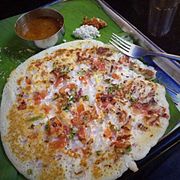 Uthappam or utthapa, a version with onion, chilli, and tomato
Uthappam or utthapa, a version with onion, chilli, and tomato
-
 Methi dosa on a pan, known as vendhyam dosai in Tamil Nadu
Methi dosa on a pan, known as vendhyam dosai in Tamil Nadu
-
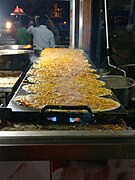 Masala dosa at a street food center
Masala dosa at a street food center
-
 "Table dosa" which covers almost half of the table
"Table dosa" which covers almost half of the table
-
 Indian street dosa masala in Varanasi, India
Indian street dosa masala in Varanasi, India
-
 Onion dosa, with coconut chutney and potato curry
Onion dosa, with coconut chutney and potato curry
-
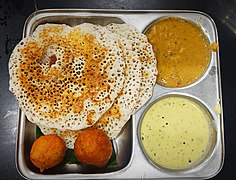 Set dosa, a set of 3 dosas with coconut chutney, curry and Mysore bonda
Set dosa, a set of 3 dosas with coconut chutney, curry and Mysore bonda
World record
On 16 November 2014, 29 chefs, at Hotel Daspalla in Hyderabad, India, created a dosa that was 16.68 m (54.7 ft) long and weighed 13.69 kg (30.2 lb), earning the Guinness World Record for the longest dosa.
In popular culture
- In a November 2019 video promoting her campaign for presidency, United States Vice President Kamala Harris cooked masala dosa with actress and comedian Mindy Kaling.
- Venba is a 2023 cooking video game that features dosa as one of the dishes that can be cooked in a long line of foods representing Tamil cuisine.
Related foods
- Uttapam: a thick relatively soft crepe mostly topped with diced onions, tomatoes, cilantro or cheese, sometimes described as an Indian pizza
- Pesarattu: made from green gram in Andhra Pradesh, served with a ginger and tamarind chutney
- Appam: a pancake prepared from patted rice batter, served with sweet coconut milk and/or sugar
- Chakuli pitha: the batter contains more black gram and less rice flour
- Apam balik: made from a mixture of flour, eggs, sugar, baking soda, coconut milk and water
- Jianbing: a Chinese dish
- Bánh xèo: a Vietnamese dish
- Lahoh: a Somali dish
- Injera: an Ethiopian dish made with fermented teff batter
See also
- List of fermented foods
- List of Indian breads
- List of pancakes
- Mangalorean cuisine
- Udupi cuisine
- Cuisine of Kerala
- South Indian cuisine
- Thali
References
- K. T. Achaya (November 2003). The Story of Our Food. Universities Press. p. 80. ISBN 81-7371-293-X.
- P. Thankappan Nair (2004). South Indians in Kolkata. Punthi Pustak. p. 320. ISBN 81-86791-50-7.
- ^ Charmaine O' Brien (15 December 2013). The Penguin Food Guide to India. Penguin Books Limited. p. 378. ISBN 978-93-5118-575-8.
- Vir Sanghvi (1 January 2004). Rude Food: The Collected Food Writings of Vir Sanghvi. Penguin Books India. pp. 109–110. ISBN 978-0-14-303139-0.
- K.T. Achaya (2003). The Story of Our Food. Universities Press. p. 85. ISBN 978-81-7371-293-7.
- "8 oldest Udupi restaurants in Bombay". The Free Press Journal. 31 May 2019. Archived from the original on 5 September 2019. Retrieved 15 August 2022.
- Bhattacharya, Bhaswati (3 August 2017). Much Ado Over Coffee: Indian Coffee House Then And Now, Bhaswati Bhattacharya, Routledge, 2017. Routledge. ISBN 978-1-351-38315-8. Archived from the original on 16 April 2023. Retrieved 28 March 2023.
- Bride at Ten, Mother at Fifteen: Autobiography of an Unknown Indian Woman, Sethu Ramaswamy, Namita Gokhale Editions, 2003
- J. Hurst, Christon, ed. (2023). "Fermented Foods of South Asia". Microbial Fermentations in Nature and as Designed Processes. Hoboken: Wiley. p. 342. ISBN 978-1-119-84999-5. OCLC 1393173167.
- Davidson, Alan (2014). "Sri Lanka". In Jaine, Tom (ed.). The Oxford companion to food (3. ed. / ed. by Tom Jaine ed.). Oxford: Oxford Univ. Press. p. 774. ISBN 978-0-19-967733-7. OCLC 903167481.
- Kadhirvel, S. (2000). "Indian Tamils in Sri Lanka: The countours of dissonance". Proceedings of the Indian History Congress. 61: 1045–1046. ISSN 2249-1937. JSTOR 44144420. Archived from the original on 3 November 2023. Retrieved 3 November 2023.
- Garg, Sanjay; SAARC Cultural Centre, eds. (2014). Circulation of cultures and culture of circulation: diasporic cultures of South Asia during 18th to 20th centuries. Colombo: SAARC Cultural Centre. p. 151. ISBN 978-955-0567-12-6. OCLC 910664759. Archived from the original on 29 June 2023. Retrieved 3 November 2023.
- "A Telugu-English Dictionary. New ed., thoroughly rev. And brought up to date...2nd ed". 1903.
- Restaurant style dosa recipe, Dosa recipe (9 July 2023). Dosa recipe.
- "Calorie Chart, Nutrition Facts, Calories in Food | MyFitnessPal | MyFitnessPal.com". www.myfitnesspal.com. Archived from the original on 19 April 2023. Retrieved 7 May 2019.
- Nutrition and Dietetics - Higher Secondary - First Year (PDF). Directorate of School Education, Government of Tamil Nadu. 2004. p. 31. Archived from the original (PDF) on 21 March 2012. Retrieved 30 August 2012.
- "A Beginner's Guide to the Great Wide World of Indian Dosa, Priya Krishna and Shailendra Krishna, October 6, 2016". 6 October 2016. Archived from the original on 9 November 2016. Retrieved 21 February 2018.
- "A Dosa Lesson From a Professional - A Good Appetite, Melissa Clark, New York Times, 6 October 2017". 6 October 2017. Archived from the original on 21 February 2018. Retrieved 21 February 2018.
- Kumar, Ashwani; Singh, Sarabjit; Tomer, Vidisha; Prasad, Rasane (2022). Cereals and cereal-based foods : functional benefits and technological advances for nutrition and healthcare (First ed.). Palm Bay, FL, USA: Apple Academic Press. p. 251. ISBN 9781000164299. Retrieved 25 April 2023.
The ingredients for dosa preparation are not limited to just rice and black gram instead pure rice or a mixture of rice, wheat, sorghum, maize, or millets can also be used.
- "Recipe: Mini soya dosa". The Times of India. Archived from the original on 24 June 2017. Retrieved 15 August 2022.
- "Mini Soya Dosa". food.ndtv.com. Archived from the original on 2 April 2015. Retrieved 20 March 2015.
- "Healthy snack recipe: Green Dosa". The Times of India. 17 February 2016. Archived from the original on 19 March 2022. Retrieved 15 August 2022.
- "Pesarattu (Green Gram Dosa)". food.ndtv.com. Archived from the original on 2 April 2015. Retrieved 20 March 2015.
- "Recipe: Light white dosa". The Times of India.
- ^ "The karam dosas from kadapa". The New Indian Express. Archived from the original on 15 August 2022. Retrieved 14 August 2018.
- "Onion Rava Dosa". food.ndtv.com. Archived from the original on 15 August 2022. Retrieved 15 August 2022.
- "Ragi Wheat Dosa". food.ndtv.com. Archived from the original on 15 August 2022. Retrieved 15 August 2022.
- Verma, Neera. South Indian Cook Book. Diamond Pocket Books (P) Ltd. ISBN 978-81-7182-836-4.
- "Longest Dosa". guinnessworldrecords.com.
- 27 November 2019. US presidential candidate Kamala Harris cooks masala dosas with Mindy Kaling Archived 23 July 2023 at the Wayback Machine. The Hindu. Retrieved 23 July 2023.
| Indian breads | |
|---|---|
| List of Indian breads | |
| Dishes |
| ||||||
|---|---|---|---|---|---|---|---|
| Side dishes |
| ||||||
| Snacks | |||||||
| Beverages | |||||||
| Sweets & desserts |
| ||||||
| Condiments | |||||||
| Ingredients | |||||||
| Burmese cuisine | |
|---|---|
| Salads | |
| Rice dishes | |
| Noodle dishes | |
| Other dishes | |
| Snacks |
|
| Drinks and beverages | |
| Seasonings and ingredients | |
| Miscellaneous | |
| Common dishes |
| ||||||||||||
|---|---|---|---|---|---|---|---|---|---|---|---|---|---|
| Snacks |
| ||||||||||||
| Desserts | |||||||||||||
| Drinks |
| ||||||||||||
| Condiments | |||||||||||||
- Dosa
- Andhra cuisine
- Burmese cuisine
- Fermented foods
- Indian breads
- Indian fast food
- Karnataka cuisine
- Kerala cuisine
- Malaysian breads
- Mangalorean cuisine
- Pancakes
- Singaporean cuisine
- South Indian cuisine
- Sri Lankan pancakes
- Tamil cuisine
- Telangana cuisine
- Vegetarian dishes of India
- Indo-Caribbean cuisine
- Hindu cuisine
- Indian cuisine
- South Asian cuisine
- Vegetarian cuisine